Guide to Nameplates
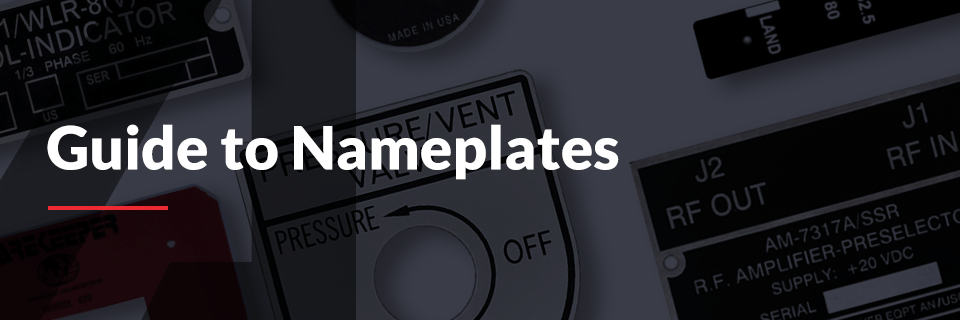
We’ve all seen them. Yet few know the intricacies of their creation, materials and types — or fabrication, substrates and make in industry speak.
They’re metal nameplates, and today we’re outlining everything you need to know about these manufactured products to make your ideal selection.
In this in-depth guide, we’ll explore different types of metal nameplates, base nameplate materials and uses, and the detailing that transforms these items into hyper-custom products curated for a range of applications — as well as what to consider when it comes time to pick a metal nameplate.
What is a Nameplate?
Metal nameplates are a form of labeling commonly uses in commercial, industrial and aesthetic applications. They’re a bold way for businesses and individuals to imprint and mount messages, whether relaying product identification information per compliance rules, mounting safety instructions or — most commonly — branding names in a unique and long-lasting way.
Depending on the nature of the nameplate design as well as its intended application, metal nameplates can be fabricated from nearly a dozen substrates, molded to multiple sizes, scales, and thicknesses, attached with various adhesives and finished with many polishes and treatments. Their versatility is their hallmark, as is the branding potential for businesses employing them.
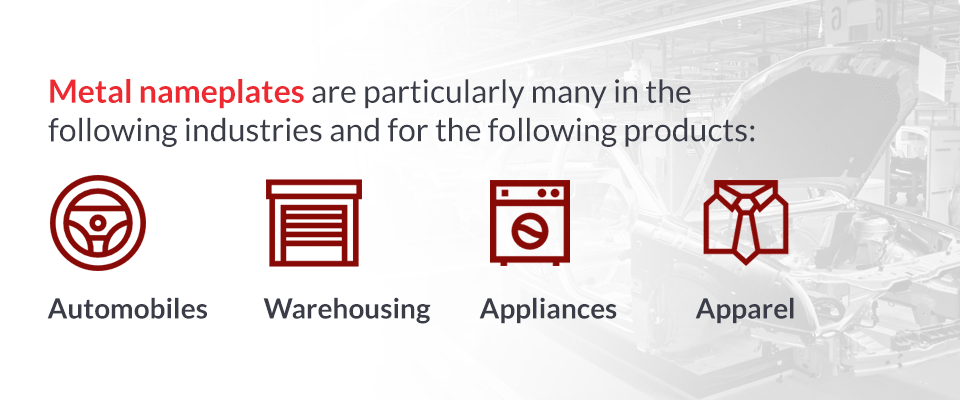
Metal nameplates are particularly many in the following industries and for the following products:
- Automobiles: From metal door plates and car logos to the serialized parts, makers and manufacturers place within their vehicles, metal nameplates are a mainstay in the automobile industry.
- Warehousing: Regulatory requirements outline rigid standards within warehouse environments to display warning signs, safety instructions, and other security messages. Depending on that warehouse environment, metal nameplates become the perfect wall-mounted option for durable instructions signs that can weather dents, knicks, moisture exposure, chemicals, and high and low temperatures.
- Appliances: It’s virtually standard for appliances to come with metal product tags and IDs displaying their brand or make. These machine labels constitute a popular application in the industry and one that sets the trend for other product identifiers, both household, and commercial.
Different Types of Nameplates
Metal nameplates are a prime choice when you have a sign or message requiring durability — but you don’t want to sacrifice appearance. At American Nameplate, we frequently see orders for the following metal-based products:
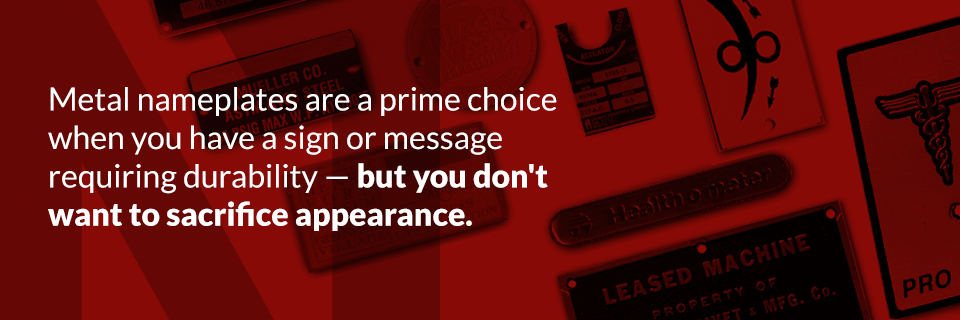
1. Corporate Nameplates
Leave printed posters behind. Your company’s name grabs attention and imbues presence and power through a metal nameplate. With the right adhesive backing or wall fastener, corporate nameplates can be mounted in strategic branding locations beyond just the lobby. What’s more, the right metal nameplate partner can scale down larger versions of company branding signs into smaller logos or machinery, boxed products, and more, keeping branding consistent and further elevating metal nameplate impact.
2. Permanent Safety Signs
Fire-exit labels, warning signs, eyewash station designations, PPE-outfitting areas, traffic route labels on warehouse floors — the list of ways metal nameplates can be turned into long-lasting, regulatory and compliant safety signs is vast.
3. Operating Instructions, Tags and Plates
Metal nameplates are a dynamic way to add weatherable instructions on tools, equipment and more. This is particularly great for items installed in harsher environments, near heat or those requiring in-the-moment, on-hand instruction, such as certain metal valve plates or pump tags in boiler rooms.
4. Machine Labels
As noted above, machine labels are staple applications for metal tags and nameplates. From household and commercial appliances to industrial equipment and machinery, this high-use, highly robust pieces of equipment require equally robust branding.
5. Engraved Tags
From small run or large runs, metal and plastic tags engraved with your company name, information and logo are stand-out paraphernalia. They’re fade-resistant, and engraved plates can come in a range of metals or 2 toned engraver plastic colors picked to complement your brand.
6. Serialized or Product Identification Plates
For products used in demanding and harsh environments, things like product identification information, serial numbers and company information cannot fade. These directly comply with industry regulatory standards as well as are required for proper machine handling and maintenance. Metal plates ensure product and printed or stamped serial IDs last as long as the machine does, regardless of surrounding conditions.
Common Nameplate Materials
There are nearly a dozen base materials that can be manufactured into metal nameplates. These substrates provide the foundation for your nameplate selection, as different nameplate materials will come with different strengths, weatherability and reactive properties that must be keenly considered to choose the right nameplate material for you.
1. Stainless Steel
Stainless steel is one of the most common nameplate materials in today’s metal etching and plate fabrication market.
Stainless steel is incredibly long-lasting. It is stain-resistant to the vast majority of environmental taints, corrosions, and moisture-related damage, and hyper-durable. It will take a lot to dent or nick a stainless steel nameplate.
What’s more, the natural metallic sheen and clean finish of stainless steel are attractive in a number of environments, ensuring you get the most for your money without forgoing appearances.
2. Aluminum
Aluminum is the next most common metal nameplate material — and for good reasons.
The metal is relatively common, making it a more cost-effective alternative to other pure metals or alloys on the list. It is also on the malleable side, ideal for custom nameplates where intricate detailing, etching or shaping work is required. Finally, aluminum is one of the lightest and least dense of pure metals. Depending on your plate application, this can provide benefits when it comes to shaping and hanging the finished plate.
Many are attracted to aluminum’s natural coloration as well, which can vary depending on geographic sourcing as well as treatments during the fabrication process.
3. Brass
Brass is notable for applications such as plaques, mounted nameplates, designated awards, emblems and more. It comes across as more luxe and decorative than other metal nameplate types, namely because of its distinct coloration that can range from gold to scarlet.
For commercial and professional uses, brass’ copper and zinc-alloy base gives it solid durability and malleability when heated. The more zinc used in the mixture, the stronger this nameplate substrate will be.
4. Bronze
Bronze, like brass, is a copper-based alloy mixed with other metals such as tin, aluminum or manganese to increase its natural strength and bolster its resistance properties. It is one of the darkest naturally dark substrates that can be used with metal nameplates, more commonly applied on aesthetic or branded features rather than signage or metal posts meant to be read quickly.
5. Cold-Rolled Steel (CRS)
Cold-rolled, or cold-formed steel, is a common fabrication technique that uses low temperatures to morph steel into its finished form.
In the case of metal nameplates, cold-rolled steel allows a blank steel canvas to be the base for insignias, apparel labels, tags and more. It’s a maintenance-friendly and tough substrate with a variety of nameplate uses.
6. Zinc
Zinc nameplates give off an industrial look with an equally industrial level of durability. Considered a “living” metal, pure zinc changes color over time and will react to moisture, chemicals, and other environmental factors, turning soft shades of green, brown and blue. However, it’s malleable and rather soft, rendering zinc nameplates more likely to scratch yet also more responsive to decorative embellishments, detailed lettering, iconography and more.
7. Nickel-Silver
Also known as German silver, nickel-silver is a cost-competitive nameplate substrate close to brass in the alloy family tree. The two alloys carry similar properties, including high malleability but some susceptibility to nicks and dents. Nickel-silver is a popular choice namely for aesthetic reasons, as its natural silver sheen and polished look adds clean and bright pops to nameplates even before they have their finish.
8. Monel
Monel is a nickel-dominant alloy comprised mostly of nickel and copper. It also contains traces of iron, carbon, and silicon, contributing to its durability and strength as well as its strong anti-corrosive properties. It is stronger than both pure nickel and pure copper.
For nameplate applications, monel is often used for signage and plates in outdoor applications, where materials need to hold up to wind, rain and other exposure to the elements.
Things to Consider When Selecting a Nameplate
Nameplate specifications are critical when selecting the right, long-lasting metal nameplate. While the principal factor that goes into picking a metal nameplate will be its intended purpose, application is only the first of a few key considerations:
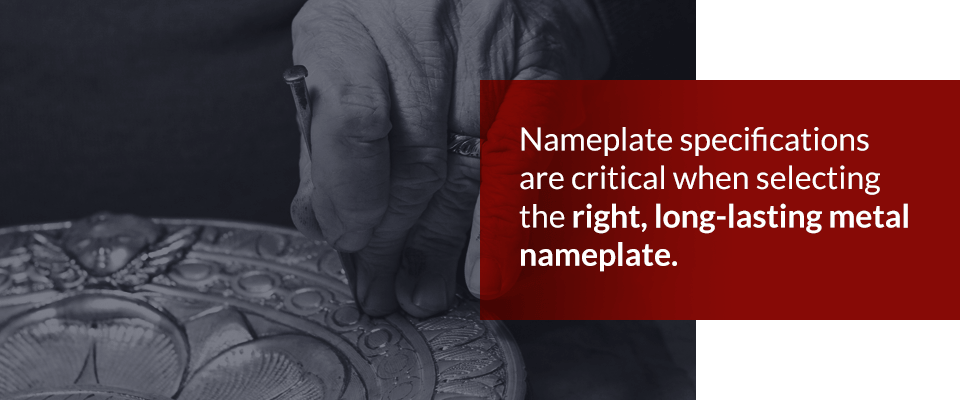
- Nameplate material: The intended use of a nameplate goes hand-in-hand with what substrate you select. For example, any nameplate that will be outside and exposed to the elements needs an anti-corrosive, elemental-resistant metal base like stainless steel, while an indoor metal nameplate can prioritize color and malleability over durability.
- Dimensions: Height, length, shape, and nameplate thickness are also essential to relay during ordering. These variables will further determine which substrate is right for your desired dimensions, as well as what detail work can be added to the finished product, such as squared, scalloped edges or rounded corners.
- Finish: Depending on the decal or nameplate’s application, it may be pertinent to apply a protective coating or laminate to increase both the product’s durability and the lifespan of the overall plate. Finishes can also be for visual effect, making a nameplate stand out that much more.
- Environmental conditions: How and where the metal nameplate will be on display directly influences all of the factors above. You will need to review the wear-and-tear your nameplate will be subjected to across its lifespan — think water, air, chemicals and oils from hand contact — plus any industry-specific conditions beyond these.
- Adhesive or fasteners: How do you plan on mounting your metal sign or nameplate, if doing so? Adhesive backings or holes for wall fasteners bind your nameplate to a surface and influence its feasible dimensions, substrates or alloys. Different finishes such as a wood, plastic, or powder coat surfaces can affect the way your adhesive choice will adhere to the product over time.
What Are Metal Nameplate Manufacturers?
Metal nameplate manufacturers are your partners in the design and creation of commercial, aesthetic or industrial nameplates.
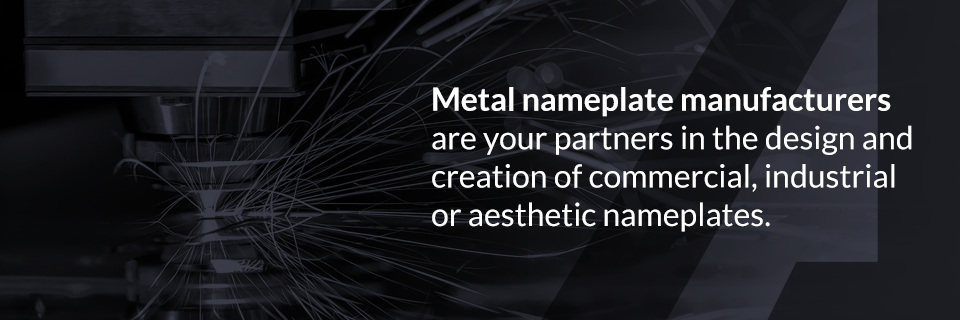
Our operations provide full-service, custom plate fabrication to cater to both small and large nameplate runs. We can consult with new and existing clients that require assistance on what kind of nameplate to choose, navigating the different types of nameplates and understanding the lifespans, affordances, and technicalities of each.
The best metal nameplate manufacturers can assist in end-to-end nameplate production. From reading blueprints and mockups to submitting final proofs and mass fabrication, our sales representatives give expertise and guidance across the entire production process to ensure you’re getting the product you need, when you need it.
Tips When Choosing an Industrial Nameplate Manufacturer
Metal nameplates are more than etched words or mounted signs. They relay what’s important, who you are and what you’re about, convey branding messages and instill a personality or set of characteristics into the goods and products associated with your name.
Whether you’re an small or large manufacturer of your own products or merchandise, there are a few tips and tricks to bear in mind when picking a metal nameplate supplier.
- Stay on-brand: Overly-embellished nameplates can appear unprofessional. On the other hand, unadorned plates or tags may work against the brand you’ve curated or even make your products appear bland and simplistic. Match your metal nameplates with current branding aesthetics, finding a supplier with the customization capabilities to do so.
- Research vendor run specialties: What is a potential supplier’s average production capacity? Will you be ordering tags, nameplates, signs, and plaques at run rates that exceed what they’ve done before — or potentially worse, are so small your orders aren’t given proper attention? Run capacities are imperative to know from the get-go to assure you don’t see production and delivery hiccups hurting your bottom line.
- Look for supplier certifications: Nameplate manufacturing has its own industry certifications that indicate independent parties have vetted a company for nameplate quality, compliance, transparency, and production protocol. There are numerous certification agencies to inquire about when vetting potential metal-fabrication partners, including FM Approvals, UL Marketing and Labeling Systems and UL Authorized Label Suppliers, Intertek Quality Assurance and RoHS 2 compliance.
- Check your own certifications and requirements: Will your nameplates need to adhere to OSHA or ANSI standards? Do they require inclusions like QR Codes or barcodes? What about military-grade industry specifications listed on the drawing or blueprint? If so, have the suppliers you’re vetting produced similar products in the past — or at least proven they’re capable of meeting these production demands?
Take Your Metal Nameplates to the Next Level
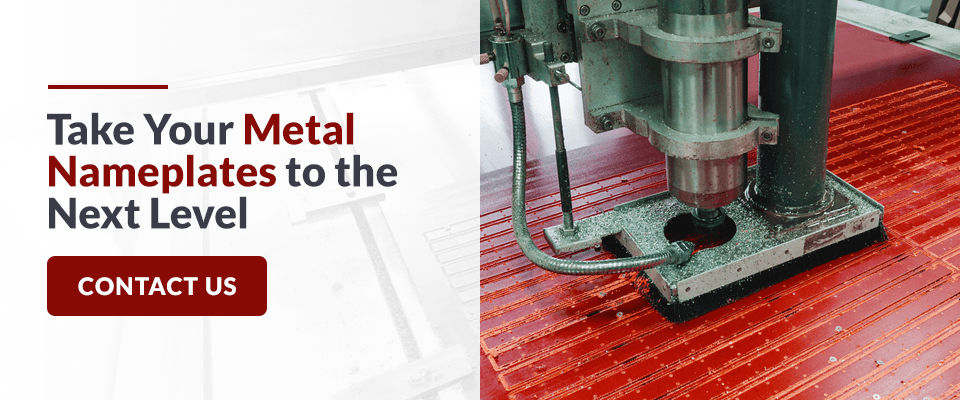
With American Nameplate, you get a metal fabrication partner that knows the importance of information and brand display — and has made a business of it for over eight decades.
We’re industry leaders in etched, engraved and screen-printed industrial metal nameplates and decals, as well as many other metal-based substrate products produced to make a mark.
Explore our portfolio of metal nameplate work or contact us today to get started on your ideal metal manufacturer partnership.











7 Comments
elangoram
Thank you sharing a blog about nameplates.Which nameplates is better looking one for Business.
Rhianna Hawk
I’m considering getting a nameplate as a gift for my boss (he just got promoted and we’re rather good friends) and I think that having a scaled down version of the company logo put in with the name would be very classy, for sure. It’s good to know that stainless steel is the most common material used, and it does sound like a good option due to the durability you described. I may consider aluminum, though, for the natural coloration you talked about.
Jocelyn McDonald
My sister wants to start her own business, and I suggested she take some time to consider what kind of name plates she wants for the office space. Your article had great information regarding this, and I liked how you said that a metal nameplate with a company’s name on it can grab attention and imbue presence and power. Thanks; I’ll share this with my sister to help her consider the name plates she wants for her future business.
Hazel Owens
That’s interesting that a nameplate company can scale down the branding sign for a business so they can use it on boxed products and so on to keep the business’ branding consistent while elevating the use of the nameplates. This would be really good for a small company since it would get their name out there and help people recognize them. It would be smart to find a sign company that could do this so the business can make a deal to work with them so they can get their logo out to the public quicker and increase awareness of their brand.
printlandokhla
Great post! Thanks for sharing very powerful post.
Charles Mathis
Very helpful post
sahil
Such a very help full blog thank you for shearing with us. A nameplate should be readable, clear, and pleasing to the eye. As a large door, you welcome people into your homes, you also welcome their energy, vibes, and auras. Chances are you won’t be able to find it if your house doesn’t have different details of its own. The nameplate design should reflect more than just your name. It should express your personality in a different style. click on link and read more about custom name plate.